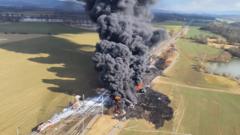Railway officials noted that the train had split apart before derailing, leading to the inferno that consumed multiple tankers. The emergency services utilized heavy foam to manage the fire's spread and even employed a helicopter and mobile chemical laboratory to monitor the situation. Approximately 15 of the 17 benzene tanks were affected, with each containing about 60 tonnes of the toxic substance.
Local residents were advised to stay indoors due to potential inhalation risks, although air quality levels reportedly remained within acceptable limits. As speculations regarding the cause of the derailment arise, police have launched an investigation into the incident.
Benzene is a well-known carcinogen, commonly found in products like plastics and detergents. Exposure can lead to severe health effects, including dizziness and long-term blood-related illnesses. The community remains on high alert as officials work to assess the full impact of this environmental disaster.
Authorities continue to address both the immediate threats from the fire and the long-term implications of the benzene spill, emphasizing the need for a thorough investigation into the derailment's causes.
Local residents were advised to stay indoors due to potential inhalation risks, although air quality levels reportedly remained within acceptable limits. As speculations regarding the cause of the derailment arise, police have launched an investigation into the incident.
Benzene is a well-known carcinogen, commonly found in products like plastics and detergents. Exposure can lead to severe health effects, including dizziness and long-term blood-related illnesses. The community remains on high alert as officials work to assess the full impact of this environmental disaster.
Authorities continue to address both the immediate threats from the fire and the long-term implications of the benzene spill, emphasizing the need for a thorough investigation into the derailment's causes.






















